Where did this medal come from? Scottish Thistle Games, Shell Mound Park, July 4th, 1891, L. A. Lamory, 2nd place - The San Francisco Examiner - 05 Jul 1891, Sun - Page 10
This is on Ebay: 1891 San Francisco Scottish Thistle Club Medal For Bicycle Race SILVER & GOLD for $499.50. I have a standard search for bicycle stuff in the 1890s, and it caught this one. I was curious about it. Seller is in Placerville, about 125 miles Northeast of where the medal was won.
Here's what I found:
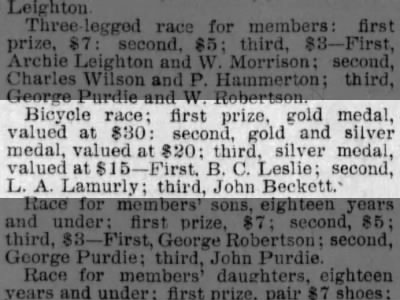 Sun, Jul 5, 1891 – 10 · The San Francisco Examiner (San Francisco, San Francisco, California, United States of America) · Newspapers.com
Sun, Jul 5, 1891 – 10 · The San Francisco Examiner (San Francisco, San Francisco, California, United States of America) · Newspapers.com
Notice the mismatch; the medal is inscribed "L. A. Lamory" but the newspaper awards it to L. A. Lamurly. Why this misspelling perhaps becomes obvious in the full article text, below. I highlighted some of the text that's funny or interesting.
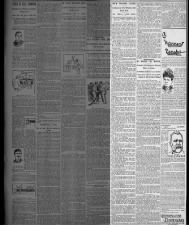 WITH TARTANS FLYING. Sun, Jul 5, 1891 – 10 · The San Francisco Examiner (San Francisco, San Francisco, California, United States of America) · Newspapers.com
WITH TARTANS FLYING. Sun, Jul 5, 1891 – 10 · The San Francisco Examiner (San Francisco, San Francisco, California, United States of America) · Newspapers.com
I made the clipping three columns wide, in case you want to read about "HE RIVALS THE RIPPER, Geronimo's Old Companion Terrorizes Parts of Arizona"
I think that a Scot might have heard 'Lamory' as 'Lamurly'. That's my theory on the misspelling. Louis' parents both emigrated from France. You can imagine what the pronunciation was.
Who was Louis A. Lamory? He was born in 1871, and grew up in Santa Clara, which was rural at that time. His family moved to Oakland in 1880. He lived on Telegraph Avenue. He worked for his brother-in-law, a produce commission merchant, in San Francisco as a clerk. He had fun. He did bicycle trips, or "runs". He defended his sister. ("If Fately has any regard for his own person he will stay away from the pretty white house at Temescal and avoid his wife's big brother and uncle.") He was a member of the Acme Athletic Club in 1891, AKA the Acme Wheelmen. I'm assuming L. L. Lamory was a typo, below. Many of the names of these charter members come up again and again in my posts about the Acme Wheelmen. I'm working on more. You'll see them again.
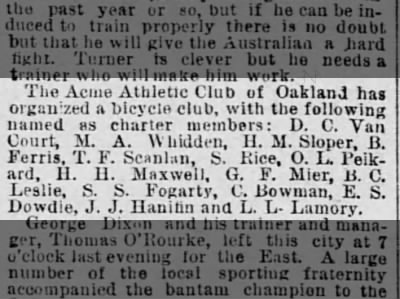 Sun, Aug 2, 1891 – 4 · The San Francisco Call (San Francisco, San Francisco, California, United States of America) · Newspapers.com
Sun, Aug 2, 1891 – 4 · The San Francisco Call (San Francisco, San Francisco, California, United States of America) · Newspapers.com
This clipping from 11/23/1891 shows that "L. A. Lamory" of the Acme Athletic Club was still racing the 'ordinary' - what we call a penny-farthing or high-wheeler bicycle - as opposed to the 'safety' bicycle, which is what we now know as a bicycle. Note that Louis won the "one-mile ordinary club champion" competition, beating Waller, Dowdle, Lund and Pickard. This means that he was likely racing an ordinary at the Scottish Thistle Club games, where he won the medal at the top of this blog post. By about 1892, everyone was on safeties.
He died in 1896. He was 24. Cause of death was consumption, which usually meant tuberculosis. His pall bearers were members of the Acme Athletic Club.
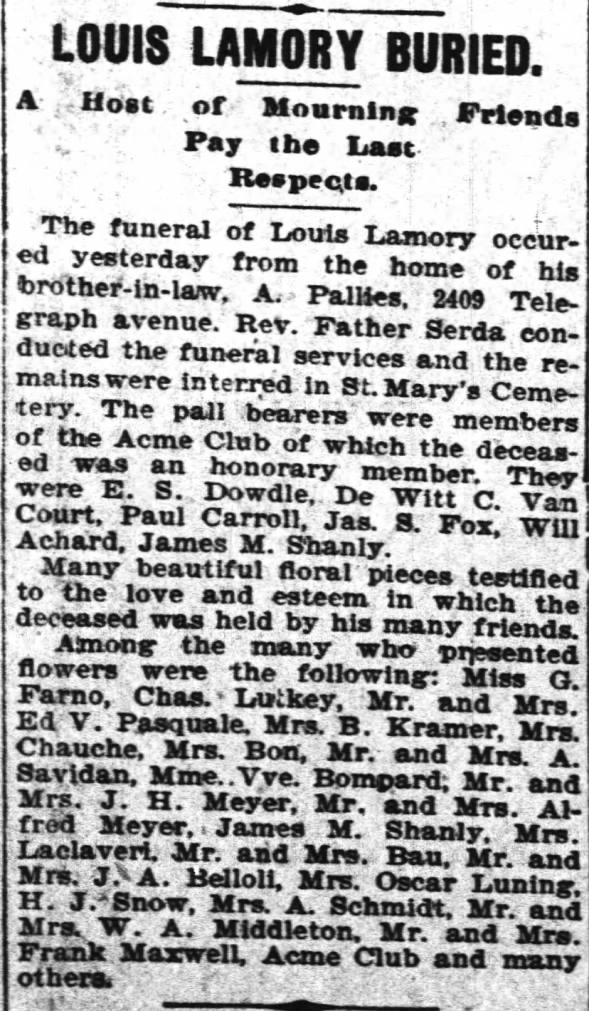 Louis Lamory Buried Wed, Apr 29, 1896 – Page 6 · Oakland Tribune (Oakland, Alameda, California, United States of America) · Newspapers.com
Louis Lamory Buried Wed, Apr 29, 1896 – Page 6 · Oakland Tribune (Oakland, Alameda, California, United States of America) · Newspapers.com
In this June 16, 1946 section of the Oakland Tribune called "The Knave" we read these reminiscences of "Lou Lamory" from James M. Shanly - who was one of Louis' pall-bearers almost exactly 50 years previous:
Where was Shell Mound Park, and the "track", mentioned above? You can use this georeferencer page to see a 1912 "Map of Oakland and Vicinity" overlaid on a modern map. Try sliding the opacity slider left and right to see then and now.
This part is distressing, and true:
The track is now part of the parking infrastructure for Bayer. Here you can see the northern turn meeting Hollis Street, in Google Maps Street View:
I can't find much references to the San Francisco Scottish Thistle Club past 1939, but 31 years after the above article was published, bicycle racers will still racing at Shell Mound Park (the track) as part of the forty-first annual picnic
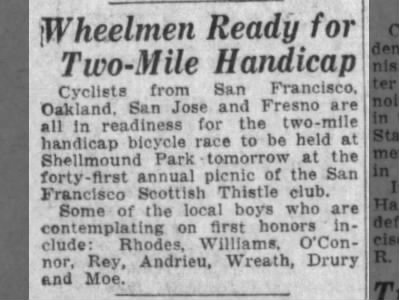 Wheelmen Ready for Two-Mile Handicap Mon, Jul 3, 1922 – 23 · The San Francisco Examiner (San Francisco, San Francisco, California, United States of America) · Newspapers.com
Wheelmen Ready for Two-Mile Handicap Mon, Jul 3, 1922 – 23 · The San Francisco Examiner (San Francisco, San Francisco, California, United States of America) · Newspapers.com
I could keep going. I got curious about those names; Rhodes, Williams, O'Connor, Rey, Andrieu, Wreath, Drury and Moe, did find out some about them. They were racers for the New Century Wheelmen. Steven O'Connor was State Champion in 1922.
Here's what I found:
 Sun, Jul 5, 1891 – 10 · The San Francisco Examiner (San Francisco, San Francisco, California, United States of America) · Newspapers.com
Sun, Jul 5, 1891 – 10 · The San Francisco Examiner (San Francisco, San Francisco, California, United States of America) · Newspapers.comNotice the mismatch; the medal is inscribed "L. A. Lamory" but the newspaper awards it to L. A. Lamurly. Why this misspelling perhaps becomes obvious in the full article text, below. I highlighted some of the text that's funny or interesting.
 WITH TARTANS FLYING. Sun, Jul 5, 1891 – 10 · The San Francisco Examiner (San Francisco, San Francisco, California, United States of America) · Newspapers.com
WITH TARTANS FLYING. Sun, Jul 5, 1891 – 10 · The San Francisco Examiner (San Francisco, San Francisco, California, United States of America) · Newspapers.comWITH TARTANS FLYING.
Scotchmen and Their Friends at Shell Mound Park.
THE THISTLE CLUB'S ANNUAL.
Ninth Annual Outdoor Gathering of the Clan - An Exciting Professional Mile Race and Other Athletic Events.
The San Francisco Scottish Thistle Club gave their ninth annual gathering and games at Shell Mound Park yesterday. The weather was all that could be desired and the cool breezes wafted over the grounds from the bay had a good effect on the athletics, particularly in the various games, which were under the direction of the following committee: Donald G. C. McKay, John Ross, Alexander Campbell, John D. Coulie, Harry Walker, Alexander Sharp, Alexander Couts, George W. Patterson and Alexander Henderson.
Clan McDonald, No. 79, from Oakland, visited the grounds in a body by the 11 o'clock train and gave three rousing cheers for the Thistle Club as they entered the gate. Then they were escorted to the officers' tent, where a generous spread was awaiting them.
Several members of the Pacific Coast Amateur Athletic Association competed in the handicap races and a great deal of interest was centered in the mile race for professionals, which was won by Archie Leighton, a member of the club. He beat Peter Mclntyre, the former champion, by over twenty yards.
Dancing was indulged in in both pavilions to music by two bands, assisted by the club pipers.
The winners or the different events and the prizes competed for are as follows:
Quoits - First prize, champion silver quoit and $5; second prize, $5; third prize, $3. First, Alexander Sharp; second, Robert Jardine; third, J. Templeton.
Boys' race, ten years and under - First prize, $3; second prize, $2; third prize, $1, First, Adam Ross; second, Robert Ross; third, William Eggebrebt.
Girls' race, ten years and under - First prize, pair of bracelets; second prize, ring; third prize, box of candy. First, Tessie Wilson; second, Josie Stirret; third, Mamie Harbet.
Standing high leap - First prize, $7; second prize, $5; third prize, $3. First, M. O'Hayes; second, William Morgan and T. J. O'Leary; third, tie; divide both prizes.
Boys' race, fifteen years and under - First prize, $3; second prize, $2; third prize, silver cup. First, George Purdie; second, George Scannell; third, Frank Cummlng.
Girls' race, fifteen years and under - First prize, pair of earrings ; second prize, parasol; third prize, purse. First, Jessie Finnie; second, Lottie Wilson; third, Jeanette Finnie.
Hop, step and Jump - First prize, $7; second prize, $5; third prize, $3. First, William Curley; second, T. Riley; third, R. G. Griffiths.
Best dressed boy in Highland costume - First prize, silver medal; second prize, dozen photos; third prize, silver badge. First, David Finnie; second, Adam Ross; third, Donald Watt.
Hitch and kick - First prize, $7; second prize, $5; third prize, $3. First, H. G. Hayes ; second, Charles Reid; third, William Curley.
Best dressed man in plain Highland costume - First prize, $7; second prize, $5; third prize, $3. First, Edward Ross; second, George Patterson; third, William Baxter.
Best dressed man in full Highland costume - First prize, $8; second prize, $6; third prize, $4. First, William Watt; second, D. McReusie; third, A. S. Matheson.
Long race for amateurs; five times around track - First prize, gold medal, valued at $35; second prize, gold and silver medal, valued at $25; third prize, silver medal, valued at $15. First W. H. Toomy, O. A. C. ; second, R. McArthur, O. A. C. ; third, N. M. McCaw, O. A. C.
Putting heavy stone - First prize, $10; second prize, $7; third prize, $5. First Tom Carroll; second, Alexander Coutts; third, M. R. McLean.
Putting light stone - First prize, $8; second prize, $6; third prize, $4. First, Tom Carroll; second, A. Coutts; third, M. R. McLean.
Best player on the bagpipes - First prize, $10; second prize, $7; third prize, $5. First, J. R. S. Tivendale; second, Ed. Ross; third, G. W. Patterson.
Old men's race, fifty years and over - First prize, box of tobacco; second prize, meerschaum pipe; third prize, cane, first. J. McGreevy; second, J. Cherry; third, D. A. Finnie.
Grand Highland reel for men in costume - First prize, $7; second prize, $5; third prize, $3. First James Baxter; second, Ed. Ross; third, G. W. Patterson and W. McKenzie, tie.
Tossing the caber (for members only) - First prize, $10; second prize, $7; third prize, $5. First M. R. McLean; second, A. Morrison; third, A. Sharp.
Sword dance for men in costume; first prize, $7; second prize, $5; third prize, $3 - First, Ed Ross; second, James Baxter; third, George Patterson.
Throwing heavy hammer; first prize. $10; second prize, $7; third prize, $5 - First Tom Carroll; second, W. A. Anderson ; third. M. R. McLean.
Throwing light hammer; first prize, $8; second prize, $6; third prize, $4 - First, Tom Carroll; second, M. A. Anderson; third, William Morgan.
Highland fling tor men in costume; first prize, $7; second prize, $5; third prize, $3 - First, Ed Ross; second, J. M. McKenzie; third, James Baxter.
Running high leap - first prise, $7; second prize, $5; third prize, $3. First, Chas. Reid; second and third, tie, W. Morgan and R. Griffiths, divide second and third prizes.
Standing long jump - First prize. $7 ; second prize, $5; third prize, $3. First, W. Morgan; second, W. Curley; third, W. Latham.
Reel o' Tulloch for men in costume - First prize, $10; second prize, $8; third prize, $6. First D. McKenzie; second, Ed. Ross; third, George Patterson.
Running long jump - First prize, $7; second prize, $5; third prize, $3. First T. Riley; second, W. Morgan; third, W. Curley.
Sailors' hornpipe for men - First prize, $7; second prize, $5; third prize, $3., First, Ed Ross; second, George W. Paterson; third, W. D. Ross.
Young ladies' race - First prize, handsome toilet set; second prize, reticule; third prize, purse. First, Lottie Wilson; second, Lilie Caccia; third, Amelia Stirett.
Short race for amateurs, twice around track - First prize, gold medal valued at $25; second prize, gold and silver medal valued At $20; third prize, silver medal valued at $12 50. First H. C. Cassidy; second, R. McArthur; third, A. S. Henderson.
Race for members, three times around track - First prize, $7; second prize, $5; third prize, $3. First A. Campbell; second, M. R. McLean ; third, John Purdie.
International tug of war, twelve men on a side, best two out of three pulls; England vs. Scotland; prize, challenge trophy, donated by Donald G. C McKay - Won by Englishmen.
Sack race; first prize $7, second prize $5, third prize $3 - First Frank Rynberg; second, D. Murphy; third, James Davis.
Race for members' wives ; first prize ton of coal, second prize pair of blankets, third prize handsome lamp - First Mrs. N. Beaton; second, Mrs. J. Baxter; third, Mrs. Gordon.
Long race for professionals, ten times around track; first prize $30; second prize $20; third prize $10 - First, Archie Leighton; second, Peter Mclntyre; third, T. Riley.
Pole vaulting, first prize. $7; second prize, $5; third prize. $3 - First Charles Reid, 9 feet 6 inches; second, Al McCormack ; third. M. R. McLean.
Obstruction race, twice around track, first prize, $10; second prize. $7; third prize, $5 - First, Tom Riley; second, Mr. Hammerton ; third, Frank Rynberg.
Putting light stone, for members only, first prize, $7; second prize, $5; third prize, $3 - First. A. Conts; second, M. R McLean ; third, W, A. Anderson.
Throwing light hammer, for members only, first prize, $7; second prize, $5 third prize. $3 - First W. A. Anderson; second, M. R. McLean; third, A. Conts.
Irish, jig and reel dancing; prize, best gentleman, $7; best ladv. $7 First, Ed Ross, best gentleman; second, Mrs. Rolff, best lady.
Short race for men, first prize, $7; second prize, $5; third prize, $3 - First F. Rynfield; second, T. Reilly; third, Archie Leighton.
Three-legged race for members: first prize, $7: second, $5; third, $3 - First, Archie Leighton and W. Morrison; second, Charles Wilson and P. Hammerton; third, George Purdie and W. Robertson.
Bicycle race; first prize, gold medal. valued at $30; second, gold and silver medal, valued at $20; third, silver medal, valued at $15 - First. B. C. Leslie; second, L.. A. Lamurly; third, John Beckett.
Race for members' sons, eighteen years and under; first prize. $7: second, $5; third, $3 - First, George Robertson; second, George Purdie; third. John Purdie.
Race for members' daughters, eighteen years and under; first prize, pair $7 shoes; second, pair of pillow-shams; third, reticule - First, Jennie Fairgrieve; second. Lottie Wilson; third, Jennie Wilson.
Games Committee race, five times around track; first prize, pair of $10 pants; second, pair of pants; third, hat - First, Alex Campbell; second, G. W. Patterson; third, A. Conte.
I made the clipping three columns wide, in case you want to read about "HE RIVALS THE RIPPER, Geronimo's Old Companion Terrorizes Parts of Arizona"
I think that a Scot might have heard 'Lamory' as 'Lamurly'. That's my theory on the misspelling. Louis' parents both emigrated from France. You can imagine what the pronunciation was.
Who was Louis A. Lamory? He was born in 1871, and grew up in Santa Clara, which was rural at that time. His family moved to Oakland in 1880. He lived on Telegraph Avenue. He worked for his brother-in-law, a produce commission merchant, in San Francisco as a clerk. He had fun. He did bicycle trips, or "runs". He defended his sister. ("If Fately has any regard for his own person he will stay away from the pretty white house at Temescal and avoid his wife's big brother and uncle.") He was a member of the Acme Athletic Club in 1891, AKA the Acme Wheelmen. I'm assuming L. L. Lamory was a typo, below. Many of the names of these charter members come up again and again in my posts about the Acme Wheelmen. I'm working on more. You'll see them again.
 Sun, Aug 2, 1891 – 4 · The San Francisco Call (San Francisco, San Francisco, California, United States of America) · Newspapers.com
Sun, Aug 2, 1891 – 4 · The San Francisco Call (San Francisco, San Francisco, California, United States of America) · Newspapers.comThis clipping from 11/23/1891 shows that "L. A. Lamory" of the Acme Athletic Club was still racing the 'ordinary' - what we call a penny-farthing or high-wheeler bicycle - as opposed to the 'safety' bicycle, which is what we now know as a bicycle. Note that Louis won the "one-mile ordinary club champion" competition, beating Waller, Dowdle, Lund and Pickard. This means that he was likely racing an ordinary at the Scottish Thistle Club games, where he won the medal at the top of this blog post. By about 1892, everyone was on safeties.
He died in 1896. He was 24. Cause of death was consumption, which usually meant tuberculosis. His pall bearers were members of the Acme Athletic Club.
 Louis Lamory Buried Wed, Apr 29, 1896 – Page 6 · Oakland Tribune (Oakland, Alameda, California, United States of America) · Newspapers.com
Louis Lamory Buried Wed, Apr 29, 1896 – Page 6 · Oakland Tribune (Oakland, Alameda, California, United States of America) · Newspapers.com
In this June 16, 1946 section of the Oakland Tribune called "The Knave" we read these reminiscences of "Lou Lamory" from James M. Shanly - who was one of Louis' pall-bearers almost exactly 50 years previous:
High-Wheeled Days
The Knave's recent article "Recalls Cycling Days," caused James M. Shanly of Auburn to dig into old possessions to uncover a picture of the times when the cycles had high wheels in front and the cyclists made imposing pictures in group formation and on cross-country runs. "On a typical run," says Shanly, one could see Lou Lamory on his big '56', bucking the Alvarado afternoon wind with Everett Dowdle, an athlete of marked ability, on his '42' riding on the lee side, both riding under the Acme Athletic Club's colors . . . a red-winged acorn on a black background . . . now used by the Athens Club, the dies for which were presented when that club came into being. On a recent Sunday those remaining of the Acme celebrated its 64th anniversary at which time the champions of their day reveled in stories of racing on ordinaries (high wheels), 'safeties', boxing, wrestling, fencing, rowing, swimming, gym work, track racing, field activities, handball and the 'parlor athletes' will have their inning. An 'ordinary' race, track or road, was always both fascinating to witness and a hard grind to the participants. The clubs participating usually being: The Bay Cities, Garden Cities, San Jose Road Club, Alameda Cyclers, Olympic Club Wheelmen, Sacramento Cycles, Reliance Club and the hard-riding Acmes. O. L. Pickard, Acme, was the first to ride the 100 miles from San Francisco to Oakland via San Jose. His record held for years. At about the height of 'ordinary' racing Bert Lund, unattached, entered the races held at the Oakland Trotting Park for benefit of building fund for the Fabiola Hospital. He had a cushioned-tired wheel and, in memory, some of those alive can hear the 'heluva protest' that went up. But it was a wheel to the judges and that was that.
Early Boxing Bouts
"A club run on 'ordinaries' was a grind. Along dirt roads, not so bad, up grade it was a case of dismount and 'shove,' down a steep grade a small tree was dragged to retard progress - if one could get the tree. Various types of hard-tired 'safeties' soon displaced the high wheels and these were followed by cushioned-tired, spring fork bicycles and then came the 'pneumatic tired' racing machine - a Phoenix, 36 pounds. Of the 10 men who rode the first 100-mile relay race around the Bay six are expected to be at the reunion: George Neece, Andy Bedburry, Theodore Schleuter, Jack Sampson, Manuel Rose and George Faulkner. Willis Sharpe was captain. Boxing conversation among the old-timers begins in 1882, when Rufus Hepburn named the club, and run through a list of such men as Eddie Wixcox, [sic, should be 'Eddie Wilcox' -MF] Jack Kitchen, Frank Leavitt, J. Mack Polk, Bert Brown, Eddie Smith, Joe Fields, Billie Gallagher, George Simpson, Billie Hughes, Jim Drew, Jed Hanifin, Dr. Walter Smythe, Jimmie Fox and Charlie Slamberg. One fight, never to be forgotten tops for excitement, was that between Walter Tye and George Kelley. The boys were disturbed by Chief of Police Thomas and the entire detective force (Shorey and Holland) in their first go on Eighth Street bridge. So decided to hold the next event under the auspices of the Acme Club, without the chief's sanction. A fellow named J. M. J. Kane, allegedly tipped it off and a raid was staged. As Kane went through the door Fred Schleuter landed a haymaker on him, at the next landing Mack Polk took a flying kick and as he went through the door one of the boys gave him 'the foot.' Which brings to mind another bout the chief interrupted and, it was told, the same fellow tipped it off. The affair took place in the early morning hours at the Coliseum Theater, 12th near Webster, between 'Buffalo' Castello and Tom Cleary. The place was surrounded by the police. All strangers were apprehended as were citizens not too well known, but men of 'standing' were permitted to pass with nod. Each thinking how lucky he was to have a 'pull.' One such person was Hugo Fuegal who, on the strength of his standin went bail for many but that afternoon four officers were busy serving warrants on those with the 'pull.' The names of Tim Scanlon, Harvey Sloper, Tom Mulvaney (Nolan's Big Boot at 11th and Broadway), George DeGolia, Clay Hawbaker, Judge Johnnie Allen, the Van Court boys, Billie Hynes, Myron Whidden, Dr. O. D. Hamlin all conjure memories of those who not only made amateur athletics what they were but the club what it was.
When Shanly writes "... Lou Lamory on his big '56', bucking the Alvarado afternoon wind with Everett Dowdle, an athlete of marked ability, on his '42' riding on the lee side..." he's referring to the diameter in inches of the front wheel. The bigger the wheel, the farther it went with one pedal revolution. When cyclists talk about gear-inches, they're trying to back-calculate to a time when the inches traveled with a pedal stroke were a fixed quantity, relating to the front wheel's outside diameter.
 |
| Sizing chart from www.standardhighwheels.se |
Where was Shell Mound Park, and the "track", mentioned above? You can use this georeferencer page to see a 1912 "Map of Oakland and Vicinity" overlaid on a modern map. Try sliding the opacity slider left and right to see then and now.
Shell Mound Park was, before the anglo or Spaniard, according to Wikipedia:
The Emeryville Shellmound, in Emeryville, California, is a sacred burial site of the Ohlone people, a once-massive archaeological shell midden deposit (dark, highly organic soil, temple and burial ground containing a high concentration of human food waste remains, including shellfish). It was one of a complex of five or six mounds along the mouth of the perennial Temescal Creek, on the east shore of San Francisco Bay between Oakland and Berkeley. It was the largest of the over 425 shellmounds that surrounded San Francisco Bay. The site of the Shellmound is now a California Historical Landmark (#335).[1]
The site is currently occupied by the Bay Street Shopping Center along with a small park in memorial to the shellmound.
The Oakland Trotting Park (references in my blog) is where Bayer and Novartis are now, in Emeryville. Interestingly, you can still make out the oval of the track in a modern satellite map:
The track is now part of the parking infrastructure for Bayer. Here you can see the northern turn meeting Hollis Street, in Google Maps Street View:
I can't find much references to the San Francisco Scottish Thistle Club past 1939, but 31 years after the above article was published, bicycle racers will still racing at Shell Mound Park (the track) as part of the forty-first annual picnic
 Wheelmen Ready for Two-Mile Handicap Mon, Jul 3, 1922 – 23 · The San Francisco Examiner (San Francisco, San Francisco, California, United States of America) · Newspapers.com
Wheelmen Ready for Two-Mile Handicap Mon, Jul 3, 1922 – 23 · The San Francisco Examiner (San Francisco, San Francisco, California, United States of America) · Newspapers.com
I could keep going. I got curious about those names; Rhodes, Williams, O'Connor, Rey, Andrieu, Wreath, Drury and Moe, did find out some about them. They were racers for the New Century Wheelmen. Steven O'Connor was State Champion in 1922.





I have a pure silver trophy from " 1904 San Francisco Thistle Club - Tug of War - championship. Would like to find proper home for it. It's worth a few.. melted for a silver bar but I think it belongs on a shelf in a club. If you know the right person or could help point me in the right direction.
ReplyDeleteThanks in advance,
James W. Reed
deerjim@sbcglobal.net